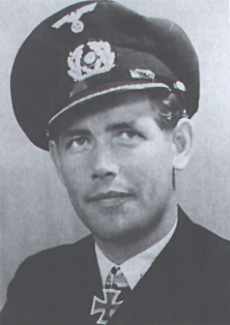The Wolfpacks
What is a Wolfpack?
The wolfpacks, known to the Germans as Rudeltaktik, were created by Karl D�nitz as a means to defeat the allied convoy system after his experiences as U-boat commander in World War 1. In June 1940 the first such operations were tried with the tactical control given to the senior officer of the group. The idea is simple enough; gather U-boats in patrol lines to scout for convoys. Once a convoy was spotted the first boat was designated "shadower" and would chase the convoy and report its heading and speed to BdU. The BdU knew of the daily positions of the U-boats and coordinated the operation against the convoy by ordering the nearby boats to form up around a convoy and to attack with as many boats as possible during the same night to overwhelm the escorts. However, in 1940 were just not enough boats for patrol lines and the first convoy battles were mainly fought by ad-hoc groups in which skilled U-boat commanders like Prien, Schepke and Kretschmer acted freely.
In May 1941 the BdU had enough U-boats to coordinate wolfpacks, but almost immediately an important event happened that had a major impact on future wolfpack operations. On 9 May, the enigma cipher machine of U-110 was captured by Britain which provided the Admiralty the ULTRA messages from which they learned about the new tactic and could re-route convoys around known patrol lines.
In 1942 the convoy operations in the North Atlantic were paused for U-boat patrols off the US east coast and the Caribbean, while the wolfpack operations in the Arctic Ocean against the convoys on the Murmansk run just began and continued to almost the last day of the war. In Mid 1942 the wolfpack operations in the Atlantic started again and became increasingly successful culminating in the biggest convoy battles in March 1943. However, the operations against convoys had to be stopped by the BdU after heavy casualties in May 1943.
Of the new technologies the HF/DF had the biggest impact on the wolfpack tactic because the contact report of the first U-boat that sighted a convoy was often located and the shadower then actively chased away by escorting aircraft or warships. After 3 months the wolfpack operations were started again with U-boats equipped with Gnat homing torpedoes, heavier anti-aircraft armament and radar detection devices but the losses were still high and the operations in the North Atlantic had to be ceased in March 1944 until the new Type XXI U-boats would be available. In this last phase the wolfpacks often had gaps in their patrol lines because U-boat had been lost and the BdU was not aware of this due the radio silence used by all boats and sometimes sent orders to U-boats that were lost weeks ago.
Around 250 such groups were formed during the war, some lasting only some days and others up to a few months. The number of U-boats in each ranged from 3-4 to around 20 in the biggest groups.



